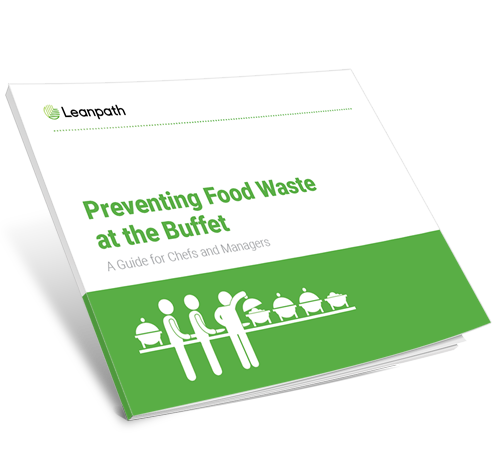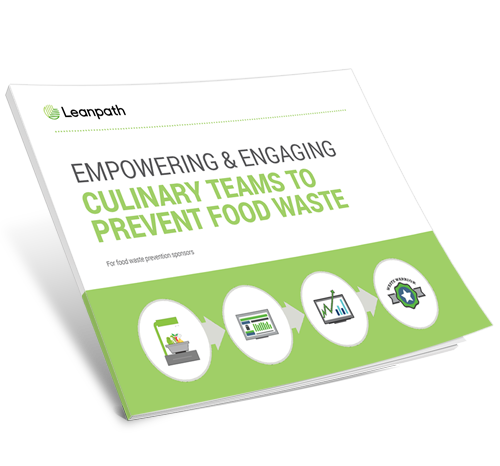12 food waste questions I get asked all the time
.png?width=2560&name=SDFSA-Training-1%20(1).png)
I’ve spent the last 2 years on the road for Leanpath, visiting more than 120 kitchens to train culinary teams how to track and reduce food waste. I've met thousands of foodservice workers, and witnessed a LOT of food waste. Here are 12 questions I get asked all the time and how I respond to each one.
Why are we tracking food waste?
For most kitchen staff, Leanpath training day is their first time thinking critically about the problem of food waste. Tracking food waste is the first step in preventing it, and by preventing food waste we're able to save all of the financial and environmental costs associated with it. I like to share the fact that if food waste were a country, it would be the third largest producer of greenhouse gasses after the US and China. We track waste so we can understand it, manage it with targeted changes to operations and behaviors, and ultimately prevent it.
I'm so busy! How will I have time for this?
This is a common question at the beginning of a training, before staff have had the opportunity to practice on the equipment. As staff quickly learn, a typical waste transaction only takes 12 seconds. The most common statement after the training? “That was so easy!”
Why do I have to separate my waste?
Tracking food waste in separate categories (vegetables, fruits, bread, etc.) is the only way to capture actionable waste information. The resulting data allows kitchens to truly understand what is being wasted and identify the biggest opportunities for reduction. Once kitchens fall into the habit of tracking waste before combining it, the practice becomes second nature.
Will I get in trouble for tracking waste?
This is a common concern, but our answer is always, "No!" In fact, we designed the program so it’s easy for kitchen management to acknowledge and reward staff participation. Tracking waste means you are doing your part and contributing to the waste reduction efforts.
Where does the information go?
This is when I get to explain the power of Leanpath Online – the website where chefs and management can look at their waste data. Leanpath Online allows culinary teams to see waste trends and identify specific reduction opportunities. We make it easy to share this information with the entire team. Kitchen staff are often eager to offer their own food waste fighting ideas!
Do we have to track everything?
Simply put, yes. Tracking accuracy is critical. We can't manage what we don't measure and things like trim waste, coffee grounds, and those little items you don't pay much attention to can sometimes be repurposed to create value added products, and certainly impact the environment when they hit landfills.
We waste HOW MUCH?
I love getting this reaction when staff realizes how much food waste really costs. At the end of each transaction we display the financial value of the item they're tossing, and what it would cost if they repeated that behavior every day for a year. Five pounds of overproduced breakfast sausage might just be a few dollars today, but if you waste it every day for a year that's thousands of dollars. Their moment of shock is my first glimpse of behavior change in action.
How long are we doing this?
Food waste prevention is a long game, and real results take real dedication - like most good things in life. The kitchens I train have usually made an organization-wide commitment to reducing food waste because of the environmental impact, the huge financial savings of food waste prevention, or the social-ethical implications of wasting food at scale. And like anything else, if you take your eye off food waste, it will inevitably creep back up as new menu items are introduced and new staff come on board. So food waste tracking and prevention isn't a one-time thing. It is now part of the kitchen culture.
How do I ensure accurate tracking?
Make it clear with staff that from this day forward food waste prevention is a priority. Select the location for your Leanpath tracker so it's convenient for staff to track waste (near prep stations or on the way to the dish area). Train staff on how to track waste -- that's where I come in -- but managers can conduct periodic refresher courses. Audit your data in Leanpath Online - the integrated camera on the Leanpath 360 tracker makes it easy to identify errors and coach to correct.
How do I keep my team engaged?
 Staff engagement is critical to the success of the program. Thankfully we have proven methods to make prevention a part of your kitchen culture. I encourage managers share data with their staff where it makes sense. Most of our clients see a 50% reduction in food waste and that's a huge number to be proud of and rally around. Recognizing highly engaged staff during stand-up is a great way to reward positive behavior and encourage others to get on board. Celebrate wins with your staff, after all front line foodservice workers are the real game changers in the global fight against food waste.
Staff engagement is critical to the success of the program. Thankfully we have proven methods to make prevention a part of your kitchen culture. I encourage managers share data with their staff where it makes sense. Most of our clients see a 50% reduction in food waste and that's a huge number to be proud of and rally around. Recognizing highly engaged staff during stand-up is a great way to reward positive behavior and encourage others to get on board. Celebrate wins with your staff, after all front line foodservice workers are the real game changers in the global fight against food waste.
How do I share my waste data with my team?
This is a common question from our program Champions looking for a way to engage their team. Luckily, our analytics platform provides several ways to share waste data with others. We encourage Champions to print, post, and talk about Leanpath data as much as possible. Use pre-shift meetings or other all-staff gatherings to talk about recent waste reduction goals and successes!
How often should I look at my data?
In the beginning of the program, we recommend Leanpath Champions log in to Leanpath Online every day to monitor the data. Once a baseline is set and the team has a better handle on their waste, a Champion may be able to log in less frequently. No matter where they are in their waste prevention journey, Champions and other program management should expect to look at the data at least once per week.
Download these guides and get started
on your food waste prevention journey today!
 Preventing Food Waste at the Buffet: A Guide for Chefs & Managers |
 Empowering & Engaging Culinary Teams to Prevent Food Waste |
